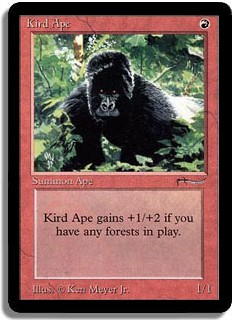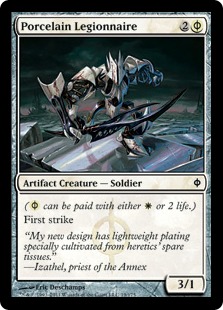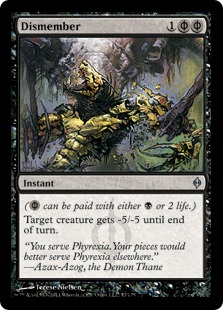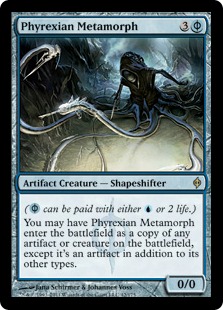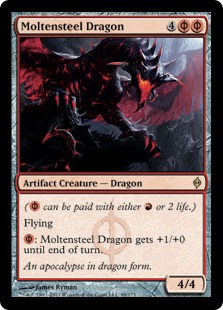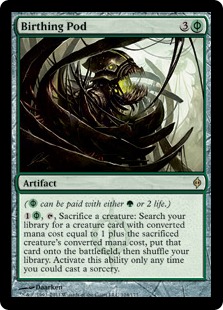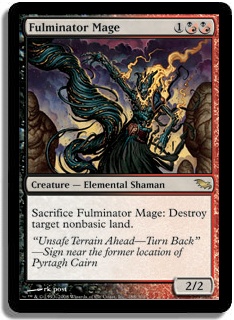Much like how my last article was inspired by a conversation at the SCG Invitational where someone said “people lack imagination,” this article is also inspired by a conversation—this time about the Magic Online Cube and the changes from when it went powered. Surprisingly, it had nothing to do with power; it had to do with Dryad Militant being cut after being the Return to Ravnica preview card and getting cut when the cards from that set went into the cube.
We noted that it may not have necessarily been cut because of cutting aggressive cards (although a good amount of aggressive support did get cut) but rather because of competition in multicolor. It seemed pretty counterintuitive because Savannah Lions and Elite Vanguard were still in the powered iteration of the Magic Online Cube but Dryad Militant got cut. Then again, the relative competition in G/W is tighter than white.
One of the hard things in cube design isn’t so much finding what cards to include but dealing with competition and what cards to cut due to space constraints. In the Magic Online Cube, Dryad Militant was one of those cards (although part of it was due to the G/W section leaning more towards midrange). Thinking about Dryad Militant, its placement as a multicolor card, and its competition with other G/W cards, as well as reflecting on other multicolor cards like Kird Ape, made me realize that it may be time for Dryad Militant to compete with other things.
In this article, I’ll talk about alternate methods of categorizing cards and how you can utilize them when designing your cube.
When I built my cube, I looked at some early lists that were available at the time. I hadn’t had too much experience with the format, but I was so enamored with my scant experiences with cubing and footage on The Magic Show that I was inspired to make my own. When looking at the lists, one of the things that stuck out was seeing Kird Ape in red when it almost always was played in Gruul. I understood why—technically it made sense because it was literally a red card—but it seemed like being placed in red was more of a technicality than how the card actually played out.
The same was true of Crystal Shard and Vedalken Shackles; I was seeing those cards in artifacts instead of blue, where they were mostly played, and decided to move them accordingly. When I began doing this with my cube and posted it online, many people thought that I was nuts, but it caught on. It’s now not uncommon to see cubes using this methodology.
I’ve heard arguments that you can run those cards in their literal categorization, but that tends to be more the exception than the rule. Kird Ape gets played much more often in Gruul decks than red decks, and even if it’s being supported by a few red fetches and a dual land, it’s still essentially being splashed, even if you’re getting some incidental value of it being a 1/1 or being able to bounce creatures with your Crystal Shard for three mana.
This is old tech, so why am I bringing it up? It’s to show how thinking about a card’s function may change how you place it in your cube to more accurately capture its role. There are a few other ways of looking at cards like this.
Recently, I thought about the Phyrexian mana cards and their role in my cube. As cube designers, we want to include cards in the sections where they’ll be optimally played—like Kird Ape in Gruul, even if it’s technically a red card. However, when thinking about these cards from a drafting point of view, we don’t think of cards like the Phyrexian mana cards in the same way since their most cost-efficient state can be used by any color. I thought about my experiences with Phyrexian mana and its place in my cube, just like when I thought about Kird Ape in my red section.
Porcelain Legionnaire is a literal white card and is at its absolute best in a base white deck since there’s the added flexibility of being able to be played in a white deck for 2W, but I found that it was played often in non-white aggro decks where the drawback of losing two life was nearly irrelevant, like B/R Aggro. I don’t crunch the maindeck percentage stats like I used to back in the day, but I did notice through casual viewing of the decks that people were drafting that people were drafting and using Porcelain Legionnaire in non-white decks enough to the point where I moved it to colorless instead.
The same happened with Phyrexian Metamorph as people typically played it decks regardless of color rather than mostly in blue, even though it was at its optimal state in blue. (In my last article about rigid evaluation, there’s a Mono-White Aggro deck featuring Phyrexian Metamorph.) Dismember quickly followed suit even though it has a double Phyrexian mana cost—which is not without precedent as the card was heavily played during its time in Standard.
Also, note the following Mono-Green Aggro deck that my friend TJ drafted from his cube featuring several Phyrexian mana cost cards:
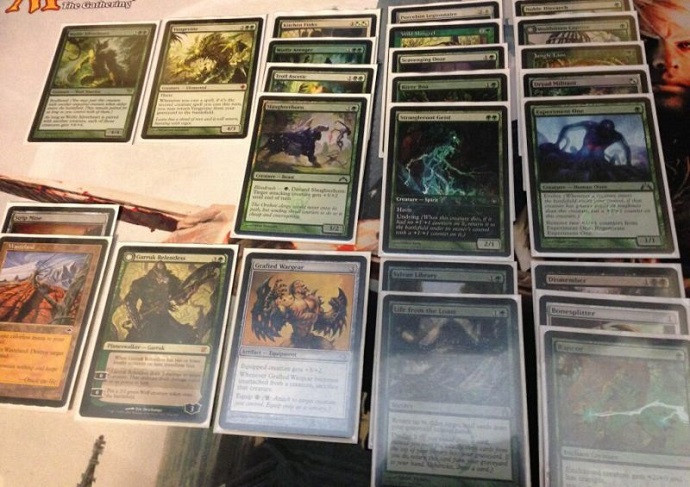
Creatures (16)
- 1 River Boa
- 1 Jungle Lion
- 1 Wild Mongrel
- 1 Troll Ascetic
- 1 Kitchen Finks
- 1 Noble Hierarch
- 1 Vengevine
- 1 Porcelain Legionnaire
- 1 Scavenging Ooze
- 1 Strangleroot Geist
- 1 Wolfbitten Captive
- 1 Wolfir Silverheart
- 1 Wolfir Avenger
- 1 Dryad Militant
- 1 Experiment One
- 1 Slaughterhorn
Planeswalkers (1)
Lands (2)
Spells (21)

However, unlike with corner cases like running Kird Ape in a R/x deck, I found that the use of Dismember, Phyrexian Metamorph, and Porcelain Legionnaire was common and felt that it was a disservice putting those cards in their respective color sections.
One thing that is important to note is that when using alternate categorization, the method need not be blanket since not all cards should be treated equally. It’s important not to categorize just according to type but mostly due to how they function.
Unlike with the previous three cards, I found that even though Moltensteel being a 4/4 flyer with Firebreathing for four is solid for any deck, it was mostly the red decks that were playing it because the life loss was too great for other decks and having to pay life for Phyrexian Firebreathing was too much for non-red decks. It was similar with Birthing Pod, which I originally placed in green and kept there since I found that for the most part, only G/x decks would run it. Other archetypes like B/W Midrange wouldn’t use it unless they really needed it even though there is a precedent for non-green decks like last Standard season’s Zombie Pod using it to success.
The nice thing about alternate categorization is being able to tinker with it and find how the cards functionally play. Two groups using the same card may find that they place the card in different sections based on the environment. If, for example, a black Pox theme is heavily supported in a cube, Birthing Pod may get played in black decks as well as green ones.
Another area of alternate categorization is for hybrid cards.
When the original Ravnica block came out, there were a few cube-worthy hybrids like Debtors’ Knell, Giant Solifuge, Rakdos Guildmage, and Azorius Guildmage, but there weren’t enough to really put a dent in multicolor sections. When Shadowmoor and Eventide came out, it increased hybrids by a ton, and many people like Evan Erwin created hybrid sections separate from multicolor. This makes sense because multicolor is a drawback whereas hybrid is a benefit; it’s pretty typical to see cards like Rakdos Cackler in a B/W deck or Kitchen Finks in a deck like G/R.
Many of these sections got disbanded since a lot of the weaker hybrid cards were frequently late picks. Even now, guilds like Simic don’t really have strong hybrids (Cold-Eyed Selkie, Snakeform, and Spitting Image were usually late picks when I tried desperately to find a good Simic hybrid just to complete a cycle) while others like Rakdos have plenty.
In addition, not all hybrids function the same, as even ones that appear pretty similar can be played with different frequency. For example, Oona, Queen of the Fae and Nightveil Specter appear similar, but Nightveil Specter has a much higher percentage of being played in U/B versus a B/X or U/X deck than Oona, Queen of the Fae thanks to its less concentrated casting cost and being a better fit for U/B control decks. Others like Mistmeadow Witch can’t really do much unless you have access to both colors, so although it’s technically a hybrid card, it plays much closer to a multicolor one. Hybrids like
Azorius Guildmage are hard to say whether they function truly as hybrid or multicolor. The blue side of Azorius Guildmage is the weaker side of it (even with it having uses like stopping fetchlands/activations of equipment) while the white side is stronger. Most decks that play Azorius Guildmage will at least have access to white mana (even something like R/W Aggro) whereas the same can’t be said of the blue side. This is similar to how a card like Firespout will almost always be played with in a deck with access to red mana but hardly ever if the deck doesn’t. So, in function, should it be considered multicolor or hybrid? Is Azorius Guildmage a case where a different environment may make it to where it gets played in blue decks as often as white decks?
Another issue with hybrid cards in cubes is that it may be the case where being hybrid places a card in tougher competition, which can cause cards to not make the grade where they may have done so if they were mono-color.
If this was mono-red or mono-black, it’d be a card that would be likely to be used in many cubes to supplement aggressive strategies while providing disruption (and be a maindeck answer to annoying lands like Maze of Ith / Library of Alexandria) However, with it being placed as a multicolor card, it isn’t competing with the anemic three-drop slot in red or black; rather, it’s competing with a now stacked Rakdos section with recent newcomers like Dreadbore, Rakdos Cackler, Olivia Voldaren, and Falkenrath Aristocrat. This means Fulminator Mage has a hard time making it in. In Selesnya, cards like Kitchen Finks and Dryad Militant fight with cards like Mirari’s Wake, Loam Lion, Knight of the Reliquary, Armada Wurm, and Sigarda, Host of Herons.
Matt Kranstuber talked about putting hybrids in the color sections. Some cards, like Inkfathom Infiltrator, play much better in specific colors; Mr. Infiltrator gets much more play in B/x decks as a decent Dauthi Slayer impersonator than in U/x decks. Placement can depend on archetype support as well. For example, a cube that doesn’t support green aggro very heavily can put a card like Boggart Ram-Gang into red since it’d hardly be played in green decks as it’s pretty weak in something like G/B Midrange but solid in something like R/W Aggro.
An idea that I’ve been tinkering with is to create a separate hybrid section and count colors. For example, you’d count a card like Kitchen Finks as one part white and one part green. After moving the cards, I would tally them up and then balance the colors (four in each color represented, for example), but as a lot of the blue hybrids aren’t very good, it’s a solution that may just be a pipe dream unless the rumors of Dragon’s Maze having a lot of hybrids comes to fruition. There is a way to get some blue cards in the hybrid section if you have your cube set up to not use all of the signets, like with the guild system, by considering cards like the Signets/bouncelands as hybrids. This may seem like a stretch, but it works because it’s on the principle that a card like Dimir Signet or Dimir Aqueduct could be used in a U/x or a B/x Control deck (but optimally in B/U).
Another method of alternate card categorization is using a “colorless” section which includes artifacts in the same section as lands and three-color cards like Sphinx of the Steel Wind and Nicol Bolas, Planeswalker. When the first cubes used structured sections (50 in each section except for 60 in multicolor, which had one of each three-color combo), competition for sections was easy to define. Nicol Bolas, Planeswalker (had it existed in the early 2000s) would have competed with Crosis and his Charm, whereas something like Masticore would have competed with things like Icy Manipulator and Dust Bowl would have competed with cards like Barbarian Ring.
One of the drawbacks about using a colorless section is that, much like how Dryad Militant competed with cards like Armada Wurm, cards like Tectonic Edge now compete with cards like Masticore and Nicol Bolas, Planeswalker. Unfortunately, it’s harder to determine not only the winner of that fight (because there’s so much more competition out there and some may operate on completely different axes) but how many of each card there should be. I’ve personally not found that there has been too much of any particular type of card, but as one of the tenets of cube design, it’s something that’s seasoned to taste.
As cube designers who aren’t held to strict section rules that a normal set would have, we can utilize many different methods of placing cards in our cubes. Don’t be afraid to think outside of traditional boundaries when defining the roles of cards in your cube.
May all of your opening packs contain Sol Rings!
@UsmanTheRad on Twitter
My blog featuring my cube lists: http://idratherbecubing.wordpress.com
Cube podcast that Anthony Avitollo and I co-host: The Third Power

